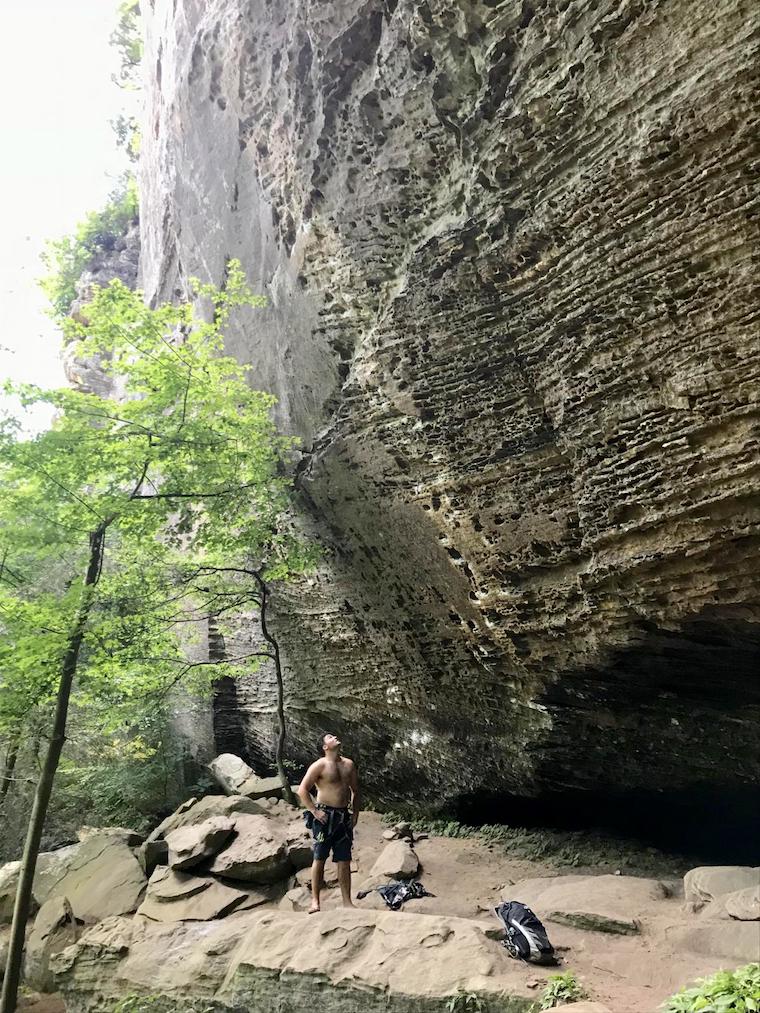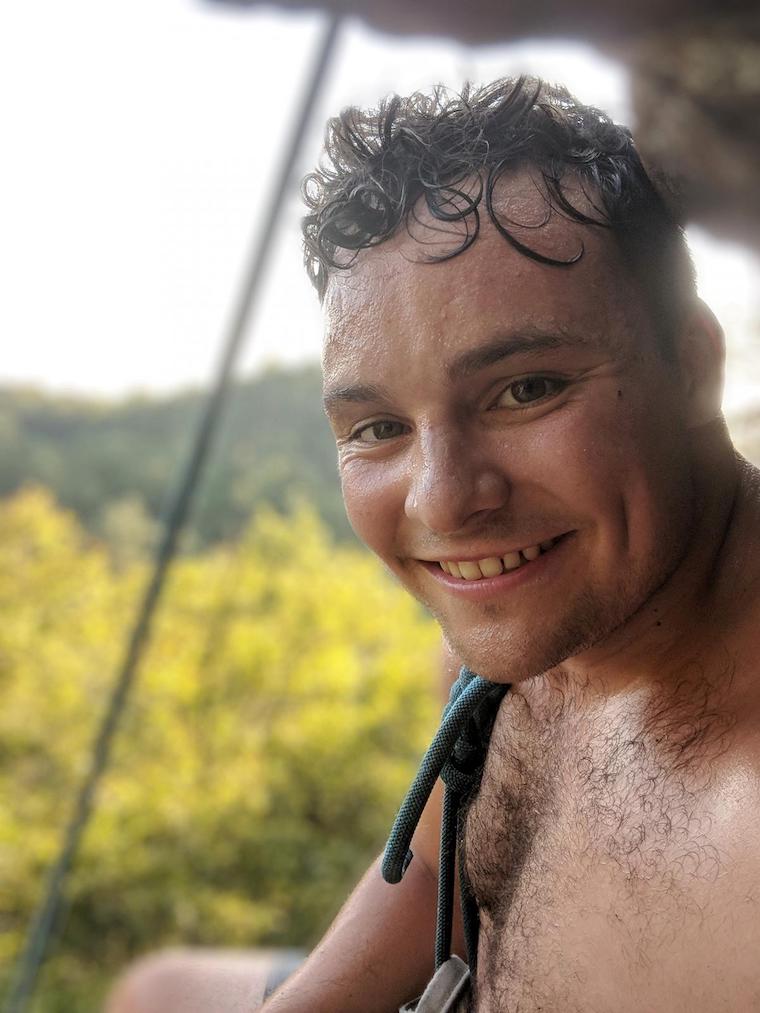Conquering Fear
Teague Harvey ’19
My forearms burned as I clung to the rock.
"I’m going for the top!”
Heart racing, I braced for the dyno. Pushing through my feet, locking off my left hand, I threw myself towards the lip.
It was Monday, July 9th, and this was the third and last day of our summer trip to the Red River Gorge.
My hand smacked the edge… and slipped right off.
“Falling!”
Air whipped past my ears as I flew towards the ground. My fall slowed as my momentum swept my belayer off the ground, and I came to stop 25 feet lower.
The climb was too overhung for me to get back on it. I was done, having fallen on the last move. I could re-lead it from the bottom again, but I knew that I didn’t have another attempt in me.
“Alright, you’re going to have to clean it”.
In sport climbing, you’re tied into a rope, which is attached to your belayer. You bring up quickdraws (two carabiners attached together), which you clip one end of into bolts in the rock. Once they’re clipped into the wall, you clip your rope into the other end of the draw, to protect you from falls on the way up. It’s quite genius in its simplicity, but it means that at the end of the day, you must get your gear back. This is done by finishing the climb, clipping yourself into the anchors with extra gear, untying your rope, feeding it through rappel rings on the anchors, retying the rope to yourself, and then grabbing the quickdraws from the wall as you rappel down. ‘Cleaning’.
If you can’t finish the climb, you need to use a ‘bail ‘biner’ - a spare locking biner you bring with you. You attach this to the highest bolt you got to, and do a similar process, rappeling off of the biner instead. However, there’s no way to get that bail biner back – hence the term, ‘bail’. You have to leave that piece of gear behind.
The climb was Scar Tissue, and it was my project. I had tried it every other time that I had been to the Red. While I had gotten to the top before, I wasn't able to do it cleanly. I had a chip on my shoulder.
It wasn’t my climbing partner’s style of climb, and I knew that if I didn’t finish and clean it, she’d have to use a bail biner… which she did.

I had psyched myself out.
It was that fear of leaving the bail biner behind (which we didn’t want to do, mind you) that caused me to fail.
Not fear of falling – but fear of failure.
And so, I self-sabotaged. The pressure got to me, and I unconsciously didn’t try my hardest.
Fear had won.
Doubt and anxiety clouded the end of junior year.
When I had started to think about my junior year summer, I placed a lot of expectations on myself.
It was my last chance to get a ‘real’ CS internship.
See, for my freshman summer I worked at SANCA, and for my sophomore summer I went to the American Dance Festival. This was my last chance to get a proper internship before I’d be graduating and in need of a ‘real job’.
As I had on Scar Tissue, I let the pressure get to me. I didn’t apply to anything in the fall – my excuse was, I was studying abroad, and I had life to experience - and by the time I started to apply in the spring, it was too little, too late.
Right as my CS friends were snapping up these amazing, well-paying internships with popular tech companies in exciting cities… I had nothing. Not even rejection emails. (Seriously recruiters, how hard can it be to send a canned rejection email?)
In the end, my adviser came through for me with this research opportunity at Oberlin...
But I still felt like a failure.
I decided to embrace the summer.
At some point, rational thought cut through my anxiety.
After all, it was too late at that point to do anything but commit to the course I had charted, right? I determined that I was going to make the most of it.
I threw myself into the research, which turned out to be much more interesting and rewarding than I worried it would be, and I enjoyed the benefits of a summer in Oberlin.
With no commute time and flexible work hours, I had time to really focus on myself, and what I wanted to do. I started meditating every day, became more adventurous in my cooking, started going on runs in the mornings and got into powerlifting. I got to really get to know some of the Obies who stuck around this summer. I had time to commit to my work, my friends, and my fitness, more so than I ever had before.
Most importantly, I pursued my primary passion, and tricked almost every day.
I found time to go to two different ‘gatherings’ – Neo 6 in Ohio, and Trickstrong VI, in New York.
What am I talking about?
I’ve already written so much about why I love the sport and movement practice of tricking, so I’m just going to stop myself here.
What you need to know, though, is that it’s primarily about freedom of expression, conquering your own fears, and continually bettering yourself.
Beginner tricks especially aren’t that biomechanically complicated – a simple backflip, for example, is dead easy. I promise. I believe that almost everyone can learn to do one. The real challenge is getting over the fear, and that’s why most people think it's a hard skill.
I’ve been tricking for two years, and this summer, I felt something monumental change. Finally attending gatherings and being a part of the community ratcheted up my confidence, and my fears started to evaporate. I was more daring in my tricking than I ever had been before.
As a result, in the last summer alone, I’ve progressed faster than I ever have before.
My tricking journey taught me how to overcome fear in my life.
When I go for a new or hard trick and I feel fear, I do one important thing.
I find the physical feeling of fear in my body.
When I was climbing Scar Tissue in July, it was a racing heart, and shallow breathing.
Once I have identified it, I acknowledge it, and assimilate it into my body. I ground my breathing and remind myself of the actual possible consequences of failure. Almost always, it’s nothing – I’ve failed other tricks before, and I know how to fall safely.
Then, I think about the path to success.
For a given trick, there’s a certain coordination of movements that I need. Usually, I’ve already drilled the pre-requisites, so I know that I am capable of the movements required.
When I’m confident that I can do it, I land it. The more I land it, the more confident I become. The stronger I become.
But Teague, what about the big fears? FOMO? Graduation? The future? Dying alone? The sun exploding?!
The beautiful thing about this process is that it scales up, and works for just about anything in your life.
- Ground yourself in your present moment somehow. I do this with breathing, because you always have time for a couple deep breaths.
- Remind yourself that the cost of failure isn’t as high as you think, and that you’ve already failed before. As they say, the sun will always rise again… unless it explodes, but we’re probably good on that front for a few more billion years. The more you fail, the better you get at dealing with it, so it’s good to fail as much as you can. I don’t set out to fail, but I’ve learned to relish it, as it always teaches me something.
- Finally, break your big problem down into smaller problems that you can solve. If you don’t think you can solve the sub-problems, you haven’t broken it down far enough. This is where I’ve really started to value my Computer Science education, as it’s taught me the actual process of problem-solving more than anything else in my life.
Let’s revisit that previous example: Teague is afraid that he’s not as good as his peers who all got internships, that he missed out on something important, and that he won’t be able to get a job after graduation.
Well, I did the breathing thing. That’s the easiest part, and it makes the rest easier.
Failure? So I don’t find a job immediately. That’s fine. There’s really plenty of jobs out there if you’re willing to work them, and I have a lot of privilege in a college education, so I probably won’t struggle as much as I fear.
Path to success? Well, the research probably looks good on my resume. I start looking for jobs early, reaching out to friends in the field, and look. And it doesn’t have to be this big, nebulous, uncertain task – I just schedule time to sit down and apply, one job at a time. And whatever experience I may have missed this summer, I can get easily get once I start somewhere.
Now it’s not always that simple. I failed to climb Scar Tissue this summer from fear of failure.
And despite all my talk, I find that the easiest fear to fall into is the fear of the future, the fear of the unknown. Give me 100 Scar Tissues. 100 new tricks to learn. Physical fear is much more approachable for me.
But the future? Nothing is certain.
Maybe I’ll get a CS job after graduation. Maybe not. Maybe I’ll run away and join the circus.
Who knows? I certainly don’t. If there’s one thing I’m going to rely on, though, it’s that:
Overcoming fear isn’t about dispelling it. It’s about embracing it.

Tags:
Similar Blog Entries
To the Sky
My thoughts on what I'd like to do post Oberlin, and how my time here has shaped those next steps.

Career Exploration at Oberlin
A deep dive into Career Exploration and Development at Oberlin.

